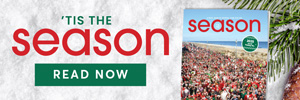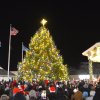June is the garden's time to bust out
In the late 1840s, June really was bustin' out all over as many of the newly invented steamboat boilers would too often explode or “bust" when driven too hard. “Bust” soon became a uniquely American English expression, so much so that by the time of the 1858 gold rush, wagons headed west carried the slogan "Pike's Peak or Bust." Many who didn't find gold went back home repainted, "Pike's Peak and Busted."
Finally “bustin'” got the respect it deserves in Rodgers and Hammerstein’s play “Carousel” with the catchy show tune “June is Bustin' Out all Over.”
June is also the safe month in the garden. You can pretty much bust out and safely transplant any plant to the garden. If the transplants are too tall or spindly, bury them a little deeper in a trench up to their first set of true leaves.
Hold off using fertilizer on your tomato plants until the first fruit has set. For any flowering or fruiting plants, limit fertilizers with too much nitrogen; this encourages growing leaves rather than fruits. Use high-nitrogen fertilizers on plants where you want leafy growth, such as corn, lettuce, Swiss chard and the greenest thing in June, your lawn.
June gardens and lawns will need extra water to make up for longer daylight and rapid growth.
A few eggshells around each tomato plant will provide calcium and avoid blossom end rot.
The long days are a great time to take softwood cuttings of spirea, lilac and viburnum. A stem is ready to use as a softwood cutting if it breaks with a snap rather than bends without breaking.
Dip the cuttings in a rooting hormone and pot up in moist, sandy potting soil. Cover with loose plastic to keep humidity and set them out of direct sunlight. You will have rooted cuttings within six weeks.
If you haven’t already fertilized your lawn, June is a good time to apply an organic slow-release fertilizer. Scatter some fertilizer or compost onto bulbs and perennial flowers. Crushed bone meal is a traditional amendment for flowerbeds and spring-blooming bulbs.
Stop pruning shrubs and trees, because it will encourage new growth that won’t mature before winter. This can lead to winter kill and destroy your plantings. June is also a good time to plant tender corms, tubers and bulbs, such as gladiolus and dahlias. A couple of dinner plate dahlias in the ground now will give you enormous blooms by late summer. Set up a birdbath near the garden to attract birds that will linger to eat garden pest insects.
By June, most early cool weather crops such as peas are harvested, and early lettuce may begin to “bolt” or go to seed. You can replace them with other quick-growing crops such as bush beans, turnips, beets and Swiss chard. If you are planting any legumes such as peas or beans, always dust them with an inoculant for higher yields. The inoculant is a form of bacteria that helps the legumes extract nitrogen. Even herbs such as basil and parsley planted now will flourish before winter. There is still time to plant most annual flowers from seed. Everything, including zinnias, four o’clocks, cosmos, and nasturtiums will bloom from seed if planted now. June may be your garden’s time to just bust out.






















































